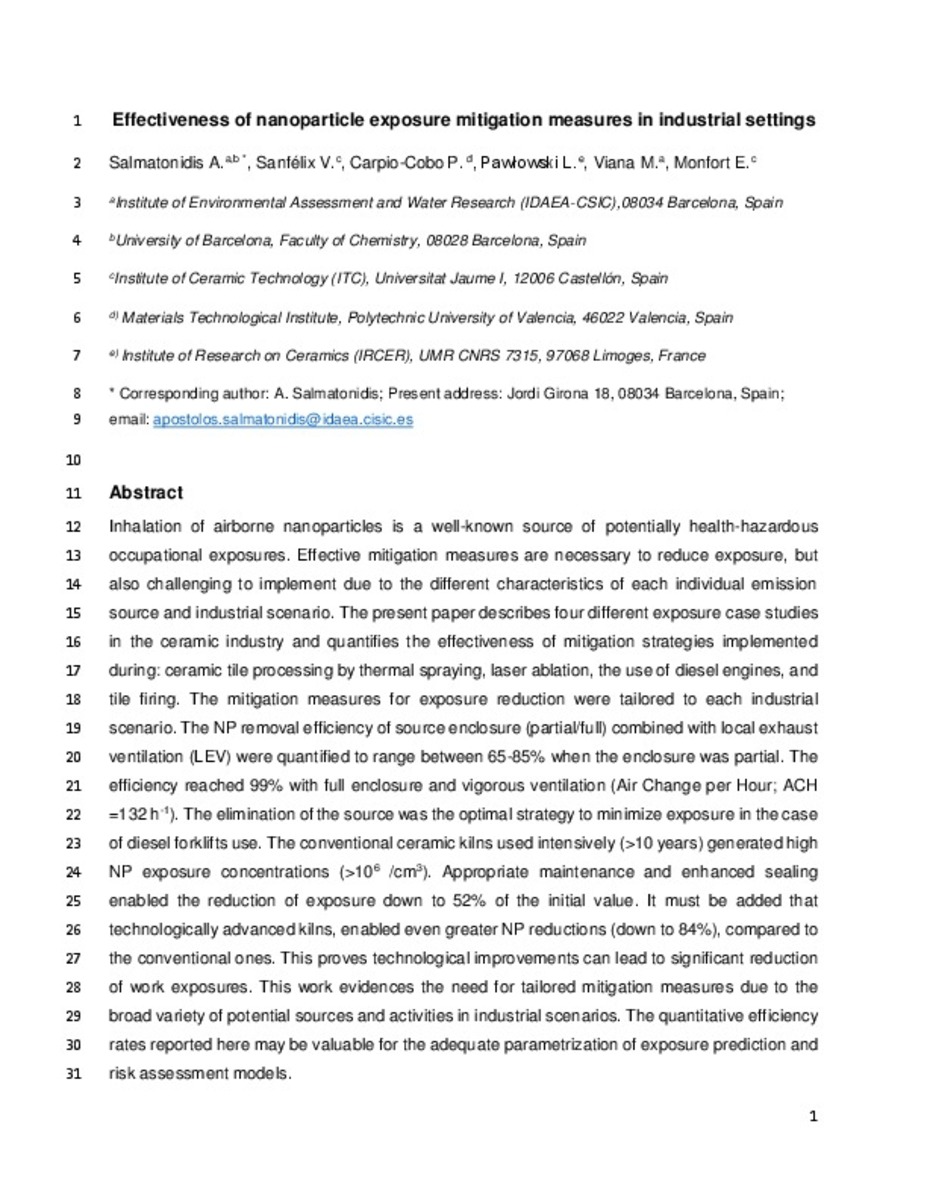Mostrar el registro sencillo del ítem
Effectiveness of nanoparticle exposure mitigation measures in industrial settings
| dc.contributor.author | Salmatonidis, Apostolos | |
| dc.contributor.author | Sanfélix Forner, Vicenta | |
| dc.contributor.author | Carpio Cobo, Pablo | |
| dc.contributor.author | Pawłowski, L. | |
| dc.contributor.author | Viana, Mar | |
| dc.contributor.author | Monfort, Eliseo | |
| dc.date.accessioned | 2019-09-20T07:44:51Z | |
| dc.date.available | 2019-09-20T07:44:51Z | |
| dc.date.issued | 2019-07 | |
| dc.identifier.citation | SALMATONIDIS, A., et al. Effectiveness of nanoparticle exposure mitigation measures in industrial settings. International journal of hygiene and environmental health, 2019, 222.6: 926-935. | ca_CA |
| dc.identifier.uri | http://hdl.handle.net/10234/183834 | |
| dc.description.abstract | Inhalation of airborne nanoparticles is a well-known source of potentially health-hazardous occupational exposures. Effective mitigation measures are necessary to reduce exposure, but also challenging to implement due to the different characteristics of each individual emission source and industrial scenario. The present paper describes four different exposure case studies in the ceramic industry and quantifies the effectiveness of mitigation strategies implemented during: ceramic tile processing by thermal spraying, laser ablation, the use of diesel engines, and tile firing. The mitigation measures for exposure reduction were tailored to each industrial scenario. The NP removal efficiency of source enclosure (partial/full) combined with local exhaust ventilation (LEV) were quantified to range between 65 and 85% when the enclosure was partial. The efficiency reached 99% with full enclosure and vigorous ventilation (Air Change per Hour; ACH = 132 h−1). The elimination of the source was the optimal strategy to minimize exposure in the case of diesel forklifts use. The conventional ceramic kilns used intensively (>10 years) generated high NP exposure concentrations (>106/cm3). Appropriate maintenance and enhanced sealing enabled the reduction of exposure down to 52% of the initial value. It must be added that technologically advanced kilns, enabled even greater NP reductions (down to 84%), compared to the conventional ones. This proves technological improvements can lead to significant reduction of work exposures. This work evidences the need for tailored mitigation measures due to the broad variety of potential sources and activities in industrial scenarios. The quantitative efficiency rates reported here may be valuable for the adequate parametrization of exposure prediction and risk assessment models. | ca_CA |
| dc.format.mimetype | application/pdf | ca_CA |
| dc.language.iso | eng | ca_CA |
| dc.publisher | Elsevier | ca_CA |
| dc.rights | © 2019 Elsevier GmbH. All rights reserved. | ca_CA |
| dc.rights.uri | http://rightsstatements.org/vocab/InC/1.0/ | * |
| dc.subject | risk assessment | ca_CA |
| dc.subject | worker health | ca_CA |
| dc.subject | hygiene and safety | ca_CA |
| dc.subject | non-engineered nanoparticles | ca_CA |
| dc.subject | ceramic industry | ca_CA |
| dc.subject | thermal processes | ca_CA |
| dc.title | Effectiveness of nanoparticle exposure mitigation measures in industrial settings | ca_CA |
| dc.type | info:eu-repo/semantics/article | ca_CA |
| dc.identifier.doi | https://doi.org/10.1016/j.ijheh.2019.06.009 | |
| dc.relation.projectID | Spanish MINECO (PCIN-2015-173-C02-01) ; Generalitat de Catalunya (project AGAUR 2017 SGR41) | ca_CA |
| dc.rights.accessRights | info:eu-repo/semantics/openAccess | ca_CA |
| dc.relation.publisherVersion | https://www.sciencedirect.com/science/article/pii/S1438463919301695#! | ca_CA |
| dc.contributor.funder | European Ceramics Centre (Limoges) ; CERASAFE project, with the support of SIINN ERA-NET (project id: 16) | ca_CA |
| dc.type.version | info:eu-repo/semantics/submittedVersion | ca_CA |
Ficheros en el ítem
Este ítem aparece en la(s) siguiente(s) colección(ones)
-
ITC_Articles [79]







